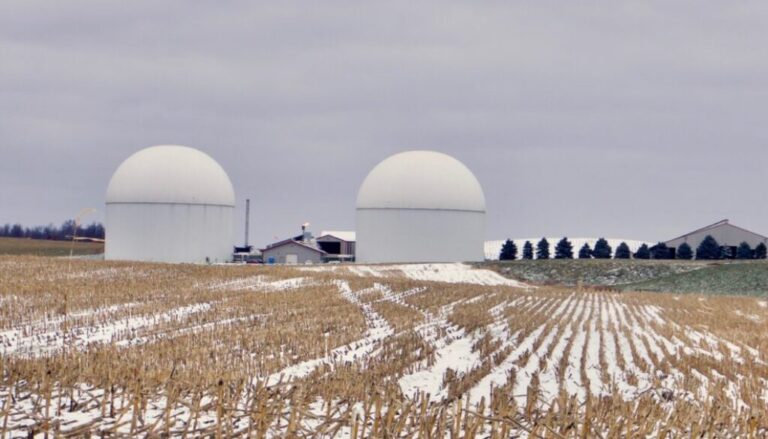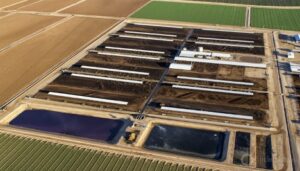
 AMES, IOWA – In a gathering that drew the attendance of both farmers and Wall Street financiers, US regulators joined with oil giant Chevron at a November conference here to promote what backers promise will be a monumental breakthrough – systemic changes that would turn polluting agricultural waste into a source of renewable energy that replaces fossil fuels and slows climate change.
AMES, IOWA – In a gathering that drew the attendance of both farmers and Wall Street financiers, US regulators joined with oil giant Chevron at a November conference here to promote what backers promise will be a monumental breakthrough – systemic changes that would turn polluting agricultural waste into a source of renewable energy that replaces fossil fuels and slows climate change.
Speakers at the conference, which was hosted by Iowa State University and co-sponsored by the Environmental Protection Agency (EPA) and the US Department of Agriculture (USDA), assured attendees that the answers to agricultural and climate woes can be found in technology that already exists: Key, according to conference promoters, is the rapid expansion of large methane biodigesters, which capture manure waste from the nation’s cattle, hog and poultry operations and convert it into a harvest of both public and private riches.
Water and air would be cleaner and farmers could see billions of dollars in new farm income, among other benefits, according to backers.
“It can provide a substantial portion of global energy needs,” Rudi Roeslein , CEO of Roeslein Alternative Energy, told the attendees. His company has built farm-based methane systems around the country that produce enough fuel to displace six million gallons of diesel fuel and 80,000 cars. “If we do this on a large scale in the US we could generate $63.6 billion worth of revenue for farmers around the country.”
Roeslein’s company promises on its website to “restore a balance” to farmland “by using the sustainably harvested biomass to create renewable natural gas.”
Chevron promotes its investment in manure biodigestion as “finding inspiration in nature.”
“I’m really excited about the innovation in this space,” Lisa Schulte Moore, a professor and co-director of the Bioeconomy Institute at Iowa State, said in an interview. “The renewable natural gas market is providing economic incentives for better management of manure.”
But critics argue that the emergence of an alliance of Big Ag, Big Oil, and Big Government to generate energy from livestock waste is ripe with peril. They say that air pollutants and waste discharged from farms and from already existing farm-based biodigesters receive scant federal and state oversight. They fear that without strict regulation, manure digesters could make water and air pollution worse, not better. Industrial-sized farms, including concentrated animal feeding operations (CAFOs), already are one of the nation’s largest sources of water pollution, and among the principal causes of air pollution.
“We’re facing a very dystopian future where we’ve turned animals in these confinement operations into our gas stations and power plants,” said Tyler Lobdell, an attorney and biodigester expert with the nonprofit environmental group Food & Water Watch. “That should alarm anyone who cares about public health or environmental protection because factory farms by their nature are designed to be extractive and polluting facilities. That’s just how they operate.”
A chief concern is that the use of larger and more numerous manure biodigesters could eventually make methane the primary profit center for CAFOs, which are now the standard for the nation’s meat and milk production.
Biodigesters could elevate manure – rather than meat or milk – to become a principal product, said Rebecca Wolf, a Food & Water Watch policy analyst.
“The reality is that you have all this manure from a factory farm system that has been a systematic part of federal policy for decades,” said Wolf. “Now we come along with a scheme to make money with it that is a Band-Aid on a completely out-of-control pollution problem.”
Promise and peril
Farmers have long known that flammable gases from piles of manure could be collected and burned. Contemporary gas production on livestock farms relies on sealing dairy, cattle, and hog manure lagoons in plastic or building big mixing tanks. Both are essentially giant crockpots that slowly cook waste in an oxygen-deprived (anaerobic) bacterial broth, allowing the release of methane to be trapped and processed for fuel.
The promise and the peril of digesting manure to produce methane has been a simmering conversation in US animal agriculture since at least 1993, when the Clinton administration released a climate action plan and established a program called AgSTAR at the EPA to promote its use. At the time, only a handful of farm-based biodigesters were in operation.
At that time, 1.46 million farms fed 163 million dairy cows, cattle, and hogs, and 5.4 billion chickens, according to the 1992 US Agriculture Census. But a sizable number of dairy cows and cattle were still being raised on pasture where their manure was spread over large ground areas as they grazed. Hogs were fed in smaller feedlots.
In the 2002 Farm Bill, Congress encouraged farmers to consider livestock waste as a source of energy with a provision that made livestock and poultry farms eligible for $450,000 grants to build biodigesters. Over the next eight years 160 biodigesters were installed on US livestock operations, according to the EPA, most of them for big dairies that used the gas to power electrical generators for farm operations.
Never, though, has the interest in biodigesters been as keen as now. The EPA counted 343 farm-based digesters at the start of 2023. The American Biogas Council, the industry’s Washington, DC-based trade group, estimates 8,600 more could be developed over the next two decades.
The biodigester bonanza is driven by two trends: First is the fact that over recent decades, the livestock and poultry sectors have grown larger, more concentrated, and have moved indoors. Twice as many cows, cattle, and hogs and 3.5 billion more chickens are raised now than in 1992. And the animals are now spread over less than 1 million farms, according to the US Agriculture Census. They annually produce 1.4 billion tons of liquid and solid manure.
Numerous federal and state studies have found that manure is responsible for much of the nitrate and phosphorus that contaminate Lake Erie, the Chesapeake Bay, most of the surface water in Iowa, much of the groundwater in Minnesota and Nebraska, and add to a mammoth toxic dead zone at the mouth of the Mississippi River in Louisiana.
The EPA has identified nutrient discharges as “the single greatest challenge to our Nation’s water quality.”
The second trend is an expansion of state and federal incentives that started in 2011 when California established a program to replace fossil transportation fuels with cleaner renewable low carbon fuels, and deemed methane production from farm biodigesters eligible for public support.
The intent was to limit emissions of methane, a greenhouse gas 80 times more potent than carbon dioxide over a 20-year time period after it’s released. Agriculture was seen as a prime culprit because livestock is responsible for more methane in the atmosphere than any other industrial sector, including oil and gas drilling and refining, according to the EPA.
California, nevertheless, sought to convert those emissions and process them into fuel for transportation or electricity. Between 2015 and the start of 2023, the California dairy sector received $214 million in state and $433 million more in matching funds to build biodigesters on 131 farms, according to state data. California also developed a carbon credit trading system that makes methane production in biodigesters a lucrative source of revenue for farmers and digester developers.
The efforts may still fall short, critics point out, because according to federal data, only 30% of methane generated in agriculture is from manure. The bulk of emissions – 70% – come from the gastroenteric releases of ruminant animals. That won’t change much, if at all, because the science for curbing belching and farting dairy cows and cattle is in its infancy.
Turning manure into money
A million BTUs (MMBTu) of methane digested from manure is currently worth $3 in the value of the gas, and about $60 in various low carbon tax credits. A typical manure lagoon filled with manure from 2,500 cows produces about 45,000 (MMBTus) of methane worth $135,000 at current prices, according to research by Aaron Smith, an agricultural and resource economist at the University of California at Davis. Another $2.75 million in carbon credits is generated. Those credits can be used by oil refineries to meet the goal California has set to reduce transportation emissions by 20% below 2010 levels by 2030.
For dairy farmers, biodigestion under the California system amounts to a total annual value of carbon credits per cow at of roughly $1,100, based on herd of 2,500, according to Smith. That is in addition to the 24,000 pounds of milk each cow produces annually, valued at more than $4,000 per cow.
Chevron jumped into the market in 2020, partnering with California Bioenergy, a renewable fuel producer, to install biodigesters on eight clusters of dairy farms in the Central Valley to turn manure from 80,000 cows into methane for transportation fuel.
The California credits are available to any company that produces methane from biodigesters and can connect to a common carrier pipeline anywhere in the US. That prompted Chevron to reach agreement with Brightmark Energy, a California-based company that has developed 23 “circularity centers” to generate methane from dairy manure, most of them in the Midwest. The five centers in Michigan, for example, include seven digesters operating on eight farms totaling over 28,000 cows.
In 2023, Chevron announced it would spend $10 billion over five years for “lower carbon projects,” including methane from farm-based biodigesters. Neither Chevron, Brightmark, nor Cal Bioenergy agreed to be interviewed. But in a public announcement Andy Walz, president of Chevron’s Americas Products, said the company is “committed to improving how affordable, reliable, ever-cleaner energy is developed and delivered.”
Other big oil companies also are engaged. BP announced a 15-year agreement with Maryland-based CleanBay Renewables in 2021 to purchase methane for transportation fuel from Chesapeake Bay poultry wastes. The same year, Enbridge, based in Canada and one of the world’s largest oil and gas pipeline companies, announced a $100 million partnership with Vanguard Renewables, a US developer of renewable gas, to build and operate up to 8 digesters in the Northeast and Midwest.
And last year Shell paid almost $2 billion to acquire Nature Energy Biogas, Europe’s largest producer of methane from agricultural wastes. Shell is developing facilities at dairy farms in Kansas, Idaho, and Wisconsin.
“The oil industry’s entrance is really worrisome,” said Andrew deCoriolis, executive director of Farm Forward, a California-based group that opposes CAFOs. “The size of the operations will follow the size of the new players. There’s a lot of new money coming in to finance the growth and consolidation of these operations, to scale them and make them more intensified. They’re going to get bigger.”
How much bigger? Smithfield, the nation’s largest hog producer, operates a feeding operation in Milford, Utah that raises 1 million pigs a year. North Dumas Farms in the Texas Panhandle feeds 72,500 cows. Riverview, a Minnesota-based milk producer, has an operation in Cochise County, Arizona that feeds 120,000 calves and heifers.
That’s a lot of manure and a lot of methane attracting a lot of money. And more is on the way.
Three years ago President Biden signed a global pledge to reduce airborne methane emissions 30% by 2030. In 2021 the White House produced a domestic methane reduction plan that focused on agricultural emissions. In 2022 President Biden signed the Inflation Reduction Act, which included $280 billion in clean energy tax breaks and other incentives to support clean fuels, reduce emissions from the transportation sector, and support clean rural electrification.
Corn Belt conference
Iowa State University, the Ames conference sponsor, is especially interested. The state’s livestock and poultry population numbers 24 million hogs, 3.6 million head of cattle, 240,000 cows, 54 million chickens, and nearly 17 million turkeys.
The university sponsored the three-day conference at its campus in Ames, which opened on Nov. 6, and drew several hundred attendees from across the country.
In presentation after presentation, faculty members and finance specialists laid out financing mechanisms for developing manure digesters and spoke of expectations for rapid growth.
“With the new incentives that are coming into focus right now, as well as all the attention that anaerobic digestors are getting, this is going to take a sharp increase,” Jake Dunton, who manages the EPA’s AgSTAR program, told conference attendees.
Other speakers assured participants that biodigesters can help eliminate the noxious odors that plague hog and dairy regions across Corn Belt states. And they said that digester wastes, called digestate, could reduce nutrient runoff that fouls surface and groundwater because the Inflation Reduction Act provides money, for instance, for farmers to grow winter cover crops, fertilized with digestate, that would limit nitrate and phosphorus runoff.
All of the assurances about the environmental value of digesters, though, leave critics unimpressed.
They say without strict regulation, the system could end up worsening farm pollution, rather than mitigating it. Currently, air emissions and waste discharges from farm-based biodigesters are largely unregulated.
The critics point out that exposing manure to heat and bacteria in an oxygen-depleted digester changes the chemistry of phosphorus and nitrates and makes them more hazardous to water.
“Land application of digester effluent, compared with fresh manure, may have a higher risk for both ground and surface water quality problems,” according to the Natural Resources Conservation Service Federal Code for operating biodigesters. “Compounds such as nitrogen, phosphorus, and other elements become more soluble due to anaerobic digestion and therefore have higher potential to move with water.”
In several states, biodigesters operated by food processors or wastewater treatment plants are tightly overseen by air and water pollution control laws. Operators must limit air emissions of hydrogen sulfide, nitrous oxide, and other gases from biodigesters at their facilities. They are required to direct the liquid portion of digestate back into the plant for treatment. Regulations are equally strict for spreading “biosolids” from biodigesters on land.
But the air emissions and digestate discharges from the very same equipment and processes installed on agricultural biodigesters are not required to operate with the same level of control for hydrogen sulfide, nitrous oxide, and other air pollutants. And digestate solids are regarded the same as manure. Farmers are free to treat farmland as waste disposal sites in Michigan and other states so long as the phosphorus, nitrates, and E. coli bacteria from manure that runs into streams and groundwater aren’t causing incidents that kill fish or make people sick.
“All these incentives to produce methane from manure amounts to a pay-to-pollute scheme,” said Wolf of Food and Water Watch. “Developers are making money off pollution. Once you start doing that, there is no incentive to roll it back.”
(This report, co-published with Circle of Blue, was made possible by an investigative reporting fellowship awarded by the Alicia Patterson Foundation and the Fund for Investigative Journalism. It is part of an ongoing series looking at how changing agricultural policies are affecting human and environmental health.)
(Keith Schneider, a former New York Times national correspondent, is senior editor for Circle of Blue. He has reported on the contest for energy, food, and water in the era of climate change from six continents. )
(Featured photo by Keith Schneider.)



